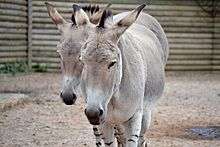Somali wild ass
| Somali wild ass | |
|---|---|
| | |
| Scientific classification | |
| Kingdom: | Animalia |
| Phylum: | Chordata |
| Class: | Mammalia |
| Order: | Perissodactyla |
| Family: | Equidae |
| Genus: | Equus |
| Species: | E. africanus |
| Subspecies: | E. a. somaliensis |
| Trinomial name | |
| Equus africanus somaliensis (Noack, 1884)[2] | |
| Synonyms[3] | |
The Somali wild ass (Equus africanus somaliensis)[3] is a subspecies of the African wild ass. It is found in Somalia, the Southern Red Sea region of Eritrea, and the Afar Region of Ethiopia.
Current distribution and habitat
There are likely less than 1000 animals (or even 700) in the wild[5] and the IUCN Red List of endangered species described it as "critically endangered". This means they face an extremely high risk of extinction in the wild.
A few hundred specimens live in Somalia, Eritrea and Ethiopia.[6] Their legs have horizontal black stripes, resembling those of a zebra.
Captivity
Global population
As of 2011, there are about 200 individuals in captivity around the globe[6] living in 34 zoos, as well as three animals in Hai-Bar, Israel (as of 2009).[7] The international studbook is managed by Tierpark Berlin.[8]
Zoo Basel
The leading zoo for breeding this rare ass is Zoo Basel, Switzerland. Its breeding program manages the European studbook for the Somali wild ass and coordinates the European Endangered Species Programme (EEP)[9] – as well as the global species committee of the Somali Wild Ass since 2004.[7]
Basel started having Somali wild asses in 1970 and had its first birth in 1972. Since then, 11 stallions and 24 females (as of 2009) were born and survived childhood.[10] Today, all Somali wild donkeys in captivity are related to the original group at Zoo Basel.[8]
As of January 18, 2012, there are four Somali wild donkeys in Basel: The stallion "Gigolo" (3) and three females (among them "Yogala"-14).[11]
United States
Only three institutions breed Somali wild ass in the United States:[12] St. Louis Zoo,[13] San Diego Zoo,[14] and White Oak Conservation in Yulee, Florida.[12] White Oak received a herd in 2008 as part of an international effort to save Somali wild ass from extinction. Since then, the herd has produced 18 foals, including several born in spring 2013.[12]
Domestication

Domestic donkeys found in Italy are typically descended from the Somali wild ass, as opposed to those from other European countries where domesticated stock are usually descended from the Nubian wild ass.[15]
Conservation
A conservation project (mainly supported by Zoo Basel) in the Northeast African country of Eritrea counts 47 Somali wild asses living in the mountains between the Buri Peninsula and the Dalool ditch.[16]
A protected population of the Somali wild ass exists in the Yotvata Hai-Bar Nature Reserve in Israel, to the north of Eilat. This reserve was established in 1968 with the view to bolster populations of endangered desert species.
Notes
- ↑ Moehlman, P.D., Yohannes, H., Teclai, R. & Kebede, F. (2008). "Equus africanus". IUCN Red List of Threatened Species. Version 2013.2. International Union for Conservation of Nature. Retrieved 20 May 2014. Assessment includes information on conservation status of two recognised subspecies.
- ↑ (German) Noack Th. (1884). "Neues aus der Tierhandlung von Karl Hagenbeck, sowie aus dem Zoologischen Garten in Hamburg". Der Zoologische Garten 25: 100-115.
- 1 2 Groves C. P. & Smeenk C. (June 2007). "The nomenclature of the African wild ass". Zoologische Mededelingen 81(1). HTM, PDF
- ↑ Sclater P. L. (1884). "On some mammals from Somali-land". Proceedings of the Scientific Meetings of the Zoological Society of London 1884: 538-542, pls. 49-50.
- ↑ Jeffrey Bonner - St. Louis Post-Dispatch (1 June 2008). "What's the Zoo to do with its Somali wild ass problem?". Saint Louis Zoo. Retrieved 20 May 2014.
- 1 2 "Seltene Schönheit - Somali-Wildeselfohlen bezaubert das Zolli-Publikum" (in German). Zoo Basel. 16 December 2010. Retrieved 22 May 2014.
- 1 2 "Somali-Wildesel (Equus africanus somalicus)". Förderprojekte der Werner Stamm Stiftung (in German). Werner Stamm Stiftung. Retrieved 2011-11-14.
- 1 2 "Somali-Wildesel" (in German). Verband Deutscher Zoodirektoren. Retrieved 22 May 2014.
- ↑ "INDIAN RHINO VISION (IRV) 2020" (in German). Zoo Basel. 8 May 2008. Archived from the original on 15 March 2012. Retrieved 22 May 2014.
- ↑ "Zweites Somali-Wildeselfohlen im Zolli geboren" (in German). Zoo Basel. 27 December 2007. Retrieved 22 May 2014.
- ↑ "Dance of the Somali wild asses". Zoo Basel. 18 January 2012. Retrieved 22 May 2014.
- 1 2 3 "Somali Wild Ass". Animal Programs. White Oak. Retrieved 22 May 2014.
- ↑ "Somali wild ass born at St. Louis Zoo". Associated Press. Retrieved 21 June 2013.
- ↑ "Three Somali Wild Ass Foals Born At San Diego Zoo Safari Park". San Diego Zoo. Retrieved 21 June 2013.
- ↑ "Pompeii Horse Is in Fact an Ass". BBC. 3 November 2010.
- ↑ "Somali Wild Ass Research Project in Eritrea". Conservation projects. Zoo Basel. Retrieved 22 May 2014.
References
- Moehlman, P. D. (ed). 2002. Equids: Zebras, Asses, and Horses: Status Survey and Conservation Action Plan. Gland, Switzerland: IUCN/SCC Equid Specialist Group
External links
- Somali wild ass at the St. Louis Zoo
- What's the Zoo to do with its wild ass problem? St. Louis Post-Dispatch, Accessed November 6, 2008
- Somali wild ass at Al Wabra Wildlife Preserve
| ||||||||||||||||||||||
